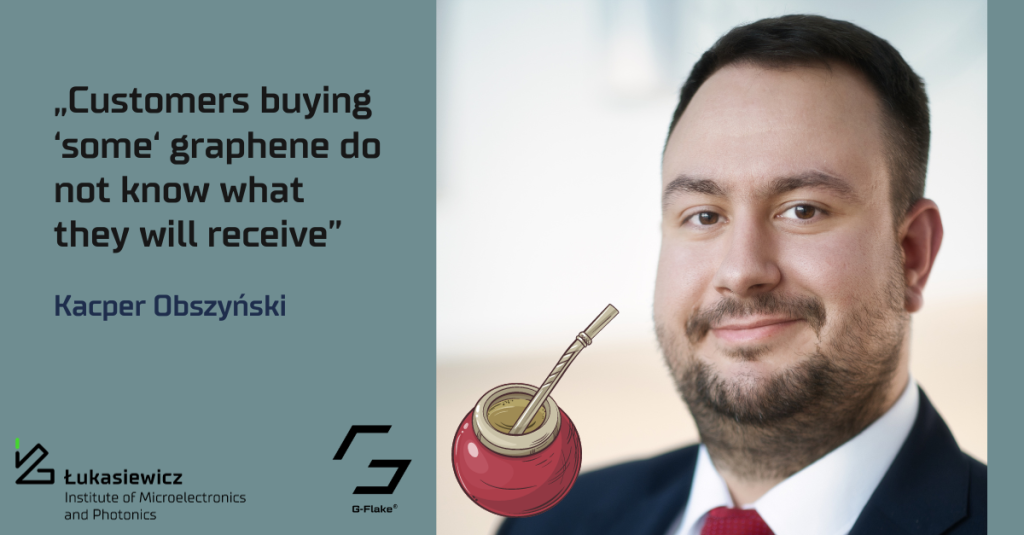
From a consulting company to a research institution – today we are talking to Kacper Obszyński, a member of the Commercialization and Sales Department, about his work – G-Flake® graphene being developed at our laboratories and about what… Kacper drinks at work.
Einstein was once asked about, where his laboratory was. The great scholar smiled, took a fountain pen out of his pocket and said, „Here.” And where is your – let’s call it – command center, as the person responsible for the commercialization of the results of our researchers’ work?
Today, the basic working tool is a computer and we will probably not be able to escape from it – unless the Sun treats us to a powerful magnetic storm, after which our laptops will only be suitable as coasters for drinks in extravagant bars of the post-information era.
For now, we are taking advantage of the benefits that the Internet offers us – there, we are looking for partners to commercialize the results of our projects, we look at and analyze what is happening in the world in the thematic areas that interest us and, of course, we boast about our successes.
However, in order not to lose contact with the real world, we often work away from the desk at meetings, fairs and conferences. Fortunately, human contact is still the foundation of business.
Why commercialization in a research institution? Why did you choose this career path?
I have already worked in various places: in two large consulting corporations, I had my own business – I ran a company with my colleagues, and together with a friend I managed to publish a book on financial education for children. And now it’s time to learn how to introduce difficult products to the market, how to make, adjust ,and think about them to turn more or less lofty ideas into real benefits.
It’s true, it would be much easier to sell Chinese socks, instead of being engaged in R&D industry.
This is true, and let’s say, I already have experience in a similar area and I decided to do something different. Back then, working here simply seemed to be something more difficult, less obvious, and required a completely different approach, because selling a product that has already existed for years, which is sold by pieces, by weight, where you have to compete with competitors, with margin, price, and so on, is different.
I had a feeling that it would look different at our Institute. After all, photonics sounds intriguing. I decided that in a research institution, the scope for changes – so-called innovations (although I don’t like this word) – is wide and you can actually enter the market with something groundbreaking. I thought it would just be a very interesting field.
…So you thought: „it’s gonna be a field day each day” Tell us a bit about G-Flake® – what is it?
One of our research groups is engaged in the production and characterization of graphene. We can boast about a finished product – flake graphene, which we sell under the G-Flake® brand. We have patented several issues related to flake graphene and its applications, including, for example, individual stages of production of flake graphene and derivative products, such as graphene paper or water-based varnish with the addition of graphene. We also have a registered trademark that we can use throughout Europe.
Why should we buy G-Flake®?
Of course, there are many different graphenes available on the market. In fact, it is difficult to clearly define what graphene is as a product. Of course, you can give a definition: graphene is a single layer of carbon atoms… and so on, but…
I knew there had to be a „but.”
Currently, there are no rules regulating the technology of producing and testing graphene materials. Therefore, from the market’s perspective, this statement is vague and the customers buying „some” graphene do not know what they will receive. It should be emphasized that the quality and physicochemical properties of graphene are influenced by some factors, such as its chemical composition, the size of individual flakes and the number of layers.
The customer can buy graphene, which will actually be a mixture of graphene and graphite (with a predominance of the latter) or mixed with soot. Then he or she will use it in their composition or paint and get no results, or at best unsatisfactory ones. The conclusion is simple – it’s rubbish.
From our point of view, this is not the most terrible thing – this is reality and we accept it as „it comes with the territory.” Fortunately, thanks to modern testing and characterization equipment, repeatability of the production process, and other magical treatments, our graphene reaches the customer as a product of the highest quality.
Well, if some have already bought graphene for themselves and is not sure whether it is a high-quality product, they can contact us!
Yes exactly. But since we were talking about quality, now let’s talk about quantity… I won’t tell anyone that graphene is a panacea and the more we add it everywhere, the better. This is not the case at all, because graphene is mostly just a „spice” – you need to know how much and what type of graphene you need to add to get the desired effect. But this is a saffron among materials!
To sum up: we do not want to simply sell as much graphene as possible, but its high quality and unique properties make the final product actually better, because thanks to this, the entrepreneur cooperating with us gains a real benefit!
I would like this benefit to be highlighted– what exactly is it?
If an entrepreneur comes to us, we are primarily interested in his needs. You may want to improve the physical properties of your product, make it more durable, you may need the composite it creates to be electrically conductive (or the opposite), or you may need the designed material to be hydrophobic. It all starts with this need, because if we know it, we will choose a material that will do the job.
That’s right – G-Flake® is not only a graphene brand, but also our… know-how, right?
Yes, we produce tailor-made graphene: along with G-Flake® graphene, we also offer our know-how. Returning to culinary and spice comparisons: to make a good dish, we must not only have ingredients of the right quality, but also know how to use it and when – so we need a recipe.
Thanks to the fact that we employ specialists who know this material very well and have been working with it for years, our „graphene recipe book” is one of the richest in the world – but there is undoubtedly much still to be discovered.
Graphene, due to its short history, will certainly surprise us more than once, and we also do not want to rest on our laurels and continue expanding our portfolio. Thanks to this, we can create a product that is more than a ready-made solution off the shelf.
On the other hand, thanks to our know-how, we do not reinvent the wheel and do not complicate matters where it is not needed. Not every situation requires a super-premium solution. We also sell widely available products, such as graphene oxide and reduced graphene oxide in the form of powder and suspension.
You work closely with our researchers to gain insight into their products and services. How would you describe yourself in this role?
This is a new situation for me, I haven’t had much contact with the scientific world before, apart from studies. For a person with an economic background, the first challenge was the phraseology – phrases such as „Raman spectroscopy” or a „quantum cascade laser” meant absolutely nothing to me. Today it is certainly much better in this respect.
The desire to cooperate with researchers requires that I have at least some knowledge of fields such as photonics or electronics – without this, in my opinion, there is no chance for successful cooperation. We need to speak a similar language to be able to cooperate – and that’s what it’s all about. I would like to be perceived by researchers as someone who can support them. This is also the essence of the functioning of the Commercialization and Sales Department. We share responsibilities so that everyone can do what they are best at.
I certainly wouldn’t like to be seen as the Government Inspector* (*a book by Nicolai Gogol) who is unable to come to his senses and came to inspect. I try to talk to people, listen empathetically and try to turn what I hear into a business opportunity.
You work in the commercialization department, in sales. I’m in marketing and I can say immodestly that we could probably promote sand in the desert. Do you know why? Because sand, for example in the Middle Eastern deserts, is of poor quality – we cannot build glass skyscrapers from it, which is why – as I heard – Dubai imports sand from Australian beaches. What else could you sell if you were given an opportunity?
I’m actually already doing it! I’m selling my knowledge, but yes – you know – in inverted comas. I try to strive to be good at what I do, so that people who pay for my time actually benefit from my knowledge, what I can do, what I have learned, and pay for the experience I have gained.
This is the operating model of scientific and research institutes, we do it every day – we sell our knowledge and inventions. I think this helped me quickly find my way in this job.
Where do you see the greatest opportunities for commercializing products and services on a global scale, not necessarily in our Institute?
It seems to me that there are many such topics that are developing very quickly now, there are many companies that operate in such areas as, for example3D printing or digitization. You also know how the use of artificial intelligence can help in everyday work. This area will develop, but it is difficult to predict the pace of the technology or products development that far, because if we look at for example the second part of „Back to the Future”, we had a flying skateboard in 2015. As we can see, we don’t commute to work on flying hoverboards, but on electric skateboards, so I’m cautious when it comes to such big breakthroughs and innovations. We do not know in which direction certain ideas may develop and whether they will develop at all or whether they will be forgotten and abandoned. Electric cars appeared already in the 19th century – even before combustion cars. So is that much changing these days?
Because… the dispute about the nature of change and development has been going on since ancient Greece: Heraclitus of Ephesus said that, the only constant is change, and Parmenides of Elea said that all change is an illusion – let’s see what the future will bring!
Finally, a private question: you are an amateur bartender, but you also have an interesting collection of drinks at work. Tell us a bit about them!
I must admit that I like to stir things up a bit from time to time! And at work, whenever possible, I like to drink yerba mate instead of tea as part of my morning ritual.
However, there is also larger ammunition on my desk – when I need a stimulating „shot”, I reach for bulletproof coffee or anhydrous caffeine.
So you have common interests with some of our researchers. You can talk about coffee with other coffee fans – our Raman spectroscopy group. Thank you for the conversation!

